Research - Geometry
Bayon Digital Archival Project | FLRS | Shape Rectification | Education Application | Non-rigid Registration | Implicit Polynomials | Fitting Implicit Polynomials |
Bayon Digital Archival Project
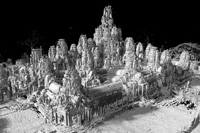 We started the Bayon Digital Archive Project in February 2003 in cooperation with the Japanese Government Team for Safeguarding Angkor (JSA). The Bayon temple is located in the center of Angkor Thom in Cambodia and is a part of UNESCO World Heritage. The temple is a very large (160m~140m~45m) and complex structure. It has also fine carvings, such as faces, pediments and relief. The motivations of this project are as follows:
We started the Bayon Digital Archive Project in February 2003 in cooperation with the Japanese Government Team for Safeguarding Angkor (JSA). The Bayon temple is located in the center of Angkor Thom in Cambodia and is a part of UNESCO World Heritage. The temple is a very large (160m~140m~45m) and complex structure. It has also fine carvings, such as faces, pediments and relief. The motivations of this project are as follows:
Publications:
- Digitally Archiving Cultural Objects , K. Ikeuchi and D. Miyazaki, Springer, New York, 2007.11.
- K. Ikeuchi, T. Oishi, J. Takamatsu, "Digital Bayon Temple -e-monumentalization of large-scale cultural-heritage objects-," Proc. ASIAGRAPH 2007, Vol. 1, No. 2, pp 99-106, 2007.
Flying Laser Range Sensor for Large-Scale Site-Modeling and Its Applications in Bayon Digital Archival Project
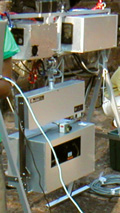 Digitizing a large-scale object requires developing new types of sensors for obtaining data of various kinds related to irregular positions. One class of such irregular positions is the very high parts of the structure occluded from the ground. In this article, we will present a novel sensing system with a moving platform, referred to as the Flying Laser Range Sensor (FLRS) for obtaining data related to these high structures from above them. The FLRS, suspended beneath a balloon, can maneuver freely in the sky and can measure structures invisible from the ground. The obtained data, however, have some distortion due to the movement of the sensor during the scanning process. In order to remedy this issue, we have developed several rectification algorithms for the FLRS. One method is an extension of the 3D alignment algorithm to estimate not only rotation and translation but also motion parameters. This algorithm compares range data of overlapping regions from ground-based sensors and our FLRS. Another method accurately estimates the FLRS's position by combining range data and image sequences from a video camera mounted on the FLRS. We evaluate these algorithms using a hardware-based method and verify that both methods achieve much higher accuracy than previous methods. This paper also briefly describes our digitization results of the Bayon temple obtained from combining the new sensor and conventional scanners.
Digitizing a large-scale object requires developing new types of sensors for obtaining data of various kinds related to irregular positions. One class of such irregular positions is the very high parts of the structure occluded from the ground. In this article, we will present a novel sensing system with a moving platform, referred to as the Flying Laser Range Sensor (FLRS) for obtaining data related to these high structures from above them. The FLRS, suspended beneath a balloon, can maneuver freely in the sky and can measure structures invisible from the ground. The obtained data, however, have some distortion due to the movement of the sensor during the scanning process. In order to remedy this issue, we have developed several rectification algorithms for the FLRS. One method is an extension of the 3D alignment algorithm to estimate not only rotation and translation but also motion parameters. This algorithm compares range data of overlapping regions from ground-based sensors and our FLRS. Another method accurately estimates the FLRS's position by combining range data and image sequences from a video camera mounted on the FLRS. We evaluate these algorithms using a hardware-based method and verify that both methods achieve much higher accuracy than previous methods. This paper also briefly describes our digitization results of the Bayon temple obtained from combining the new sensor and conventional scanners.
Publications:
- A. Banno, T. Masuda, T. Oishi and K. Ikeuchi, gFlying Laser Range Sensor for Large-Scale Site Modeling and Its Applications in Bayon Digital Archival Projecth, Int. Journal of Computer Vision, Vol.78, No.2-3, pp.207-222, July, 2008.
- A. Banno and K. Ikeuchi, " Acquisition and Rectification of Shape Data Obtained by a Moving Range Sensorh, IPSJ Trans. on Computer Vision and Image Med, No.SIG9(CVIM18), pp.21-38, June, 2007
Shape Rectification of Distorted Range Data Given by a Moving Range Sensor based on Alignment
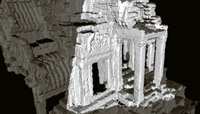 Scanning by a moving range sensor from the air is one of the most effective methods to obtain range data of large-scale objects since it can measure some regions invisible from the ground. The obtained data, however, have some distortions due to the sensor motion during the scanning period. Besides these distorted range data obtained by moving sensors, there should be available range data sets taken by other sensors fixed on the ground. Based on the overlapping regions visible from the moving sensor and the fixed ones, we propose an extended alignment algorithm to rectify the distorted range data and to align the date to the models by the fixed sensors. By using CG models, we estimate the accuracy and effectiveness of our proposed method. Then we apply it to some real data sets to prove the validity of the method.
Scanning by a moving range sensor from the air is one of the most effective methods to obtain range data of large-scale objects since it can measure some regions invisible from the ground. The obtained data, however, have some distortions due to the sensor motion during the scanning period. Besides these distorted range data obtained by moving sensors, there should be available range data sets taken by other sensors fixed on the ground. Based on the overlapping regions visible from the moving sensor and the fixed ones, we propose an extended alignment algorithm to rectify the distorted range data and to align the date to the models by the fixed sensors. By using CG models, we estimate the accuracy and effectiveness of our proposed method. Then we apply it to some real data sets to prove the validity of the method.
Publications:
- Banno and K. Ikeuchi, "Shape Rectification of Distorted Range Data Given by a Moving Range Sensor based on Alignment", The IEICE Trans. on Information and Systems (Japanese Edition), to appear
Educational Application of Digital Contents Using 3D Digital Archive Data
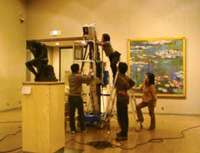 3-D digital archiving of real objects, especially cultural assets and art objetcs, is actively studied. 3-D digital models have several features compared to real objects: arbitrariness of viewpoint, model shape, and photometric attributes (color and direction of light source, material of the model), which can be effectively applied to educaitons, in addition to archeological validations. We organized a class for undergraduates where students create video contents using a sculpture hThe Thinkerh by Rodin as a subject, under the purpose to let them deepen their understanding of Rodin, hThe Thinkerh, and fusing art and scientific technology, and verified the effect.
3-D digital archiving of real objects, especially cultural assets and art objetcs, is actively studied. 3-D digital models have several features compared to real objects: arbitrariness of viewpoint, model shape, and photometric attributes (color and direction of light source, material of the model), which can be effectively applied to educaitons, in addition to archeological validations. We organized a class for undergraduates where students create video contents using a sculpture hThe Thinkerh by Rodin as a subject, under the purpose to let them deepen their understanding of Rodin, hThe Thinkerh, and fusing art and scientific technology, and verified the effect.
Publications:
- M. Kamakura, T. Kakuta, K. Ikeuchi, M. Aoyagi, gEducational Application of Digital Contents ?Using 3D Digital Archive Data of gThe Thinkerh by Rodin-h, The Journal of The Institute of Image Information and Television Engineers, Vol.62 No.2, 2008 (in Japanese)
Non-rigid Registration Method for Analysis of Ancient Mirrors
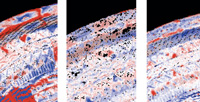 In this research, we developed a non-rigid registration method for analyzing ancient mirrors. hSankakubuchi-Shinjyukyoh or the ancient mirrors which were supposedly brought into Japan during the 3rd century, are said to have been replicated multiple times. During the replication, scars are sometimes created, and these are passed onto the child mirrors. By using our method, we are able to reduce the random deformations on the original mirrors, leaving the scars on the mirrors more visible. First we split one of the mirrors using a threshold value to separate the parts with a large deformation. These parts are re-aligned, using a rigid-registration method, to the mirror being compared to. Then this alignment result would be used as a target, and the original mirror would be deformed to match the re-aligned mirror. The deformation process is done using the Free-Form Deformation method. The result gives us a clearer view of the scars, which are useful for archaeological analysis, since the differences are difficult to spot with the naked eye.
In this research, we developed a non-rigid registration method for analyzing ancient mirrors. hSankakubuchi-Shinjyukyoh or the ancient mirrors which were supposedly brought into Japan during the 3rd century, are said to have been replicated multiple times. During the replication, scars are sometimes created, and these are passed onto the child mirrors. By using our method, we are able to reduce the random deformations on the original mirrors, leaving the scars on the mirrors more visible. First we split one of the mirrors using a threshold value to separate the parts with a large deformation. These parts are re-aligned, using a rigid-registration method, to the mirror being compared to. Then this alignment result would be used as a target, and the original mirror would be deformed to match the re-aligned mirror. The deformation process is done using the Free-Form Deformation method. The result gives us a clearer view of the scars, which are useful for archaeological analysis, since the differences are difficult to spot with the naked eye.
Publications:
- K. Fujiwara, J. Takamatsu and K. Ikeuchi, gAnalysis of Ancient Mirrors using Non-rigid Registration Methodh in IPSJ SIG-CVIM: Computer Vision and Image Media 161, Jan. 2008 (in Japanese).
3D Model Segmentation and Representation using Implicit Polynomials
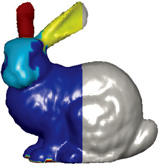 When large-scale and complex 3D objects are obtained by range finders, it is often necessary to represent them by algebraic surfaces for such purposes as data compression, multi-resolution, noise elimination, and 3D recognition. Representing the 3D data with algebraic surfaces of an implicit polynomial (IP) has proved to offer the advantages that IP representation is capable of encoding geometric properties easily with desired smoothness, few parameters, algebraic/geometric invariants, and robustness to noise and missing data. Unfortunately, generating a high-degree IP surface for a whole complex 3D shape is impossible because of high computational cost and numerical instability. We propose a 3D segmentation method based on a cut-and-merge approach. Two cutting procedures adopt low-degree IPs to divide and fit the surface segments simultaneously, while avoiding generating high-curved segments. A merging procedure merges the similar adjacent segments to avoid over-segmentation. To prove the effectiveness of this segmentation method, we open up some new vistas for 3D applications such as 3D matching, recognition, and registration.
When large-scale and complex 3D objects are obtained by range finders, it is often necessary to represent them by algebraic surfaces for such purposes as data compression, multi-resolution, noise elimination, and 3D recognition. Representing the 3D data with algebraic surfaces of an implicit polynomial (IP) has proved to offer the advantages that IP representation is capable of encoding geometric properties easily with desired smoothness, few parameters, algebraic/geometric invariants, and robustness to noise and missing data. Unfortunately, generating a high-degree IP surface for a whole complex 3D shape is impossible because of high computational cost and numerical instability. We propose a 3D segmentation method based on a cut-and-merge approach. Two cutting procedures adopt low-degree IPs to divide and fit the surface segments simultaneously, while avoiding generating high-curved segments. A merging procedure merges the similar adjacent segments to avoid over-segmentation. To prove the effectiveness of this segmentation method, we open up some new vistas for 3D applications such as 3D matching, recognition, and registration.
Publications:
- B. Zheng, J. Takamatsu and K. Ikeuchi, "3d model segmentation and representation with implicit polynomials," IEICE Trans. on Information and Systems, E91-D(4): pp1149-1158, 2008.
An Adaptive and Stable Method for Fitting Implicit Polynomials to Curves and Surfaces
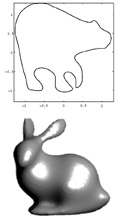 Representing the 2D and 3D shapes of target objects with implicit polynomials (IPs) has been attractive because of its applicability to various computer vision issues. Many IP fitting methods have already been proposed. However, these methods are inflexible for deciding the degree of IP and cannot achieve computational stability in fitting without losing accuracy. We propose a stable and accurate fitting method that automatically determines the moderate degree required.
Our method increases the degree of IP until a satisfactory fitting is achieved. The incrementability of the QR decomposition with Gram-Schmidt orthogonalization gives our method computational efficiency. Furthermore,
since the decomposition detects the instability element precisely, our method selectively apply ridge regression-based constraints only to that element. As a result, our method achieves computational stability while maintaining fitting accuracy. The following results demonstrate the effectiveness of our method.
Representing the 2D and 3D shapes of target objects with implicit polynomials (IPs) has been attractive because of its applicability to various computer vision issues. Many IP fitting methods have already been proposed. However, these methods are inflexible for deciding the degree of IP and cannot achieve computational stability in fitting without losing accuracy. We propose a stable and accurate fitting method that automatically determines the moderate degree required.
Our method increases the degree of IP until a satisfactory fitting is achieved. The incrementability of the QR decomposition with Gram-Schmidt orthogonalization gives our method computational efficiency. Furthermore,
since the decomposition detects the instability element precisely, our method selectively apply ridge regression-based constraints only to that element. As a result, our method achieves computational stability while maintaining fitting accuracy. The following results demonstrate the effectiveness of our method.
Publications:
- B. Zheng, et al., "Adaptively Determining Degrees of Implicit Polynomial Curves and Surfaces," Proc. 8th Asian Conf. on Computer Vision (ACCV2007), No.2, pp. 289-300, 2007.


